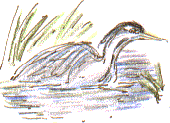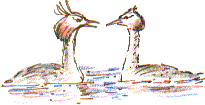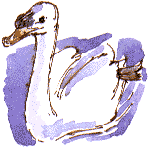Nature Diary
Rocks
History
Gallery
Links
Home Page
 AT THE SHALLOW top end of Newmillerdam lake near Wakefield, dead trees stand like stags' antlers. They were flooded by mining subsidence years ago. Gulls perch on the sun-bleached branches.
AT THE SHALLOW top end of Newmillerdam lake near Wakefield, dead trees stand like stags' antlers. They were flooded by mining subsidence years ago. Gulls perch on the sun-bleached branches.
 On a small scale, it's the kind of wild wetland scene that is popular as a setting in American wildlife art.
On a small scale, it's the kind of wild wetland scene that is popular as a setting in American wildlife art.
A Heron stands motionless, up to the tops of its legs in water, by a clump of reeds.
 A male Great-crested Grebe calls; a kind of urgent, peevish grunt. It's not a sound that I'd associate with waterfowl. The male is the one with the long crests and the larger cheek ruffs. The female joins him and they greet each other in a head-shaking display, their heads turning from side to side, rather than up and down.
A male Great-crested Grebe calls; a kind of urgent, peevish grunt. It's not a sound that I'd associate with waterfowl. The male is the one with the long crests and the larger cheek ruffs. The female joins him and they greet each other in a head-shaking display, their heads turning from side to side, rather than up and down. Then they dive briefly and swim along beside each other, preening in what seems a slightly ritualised fashion. Then they dive briefly and swim along beside each other, preening in what seems a slightly ritualised fashion.
We also hear a Mute Swan give a grunting call. As the name suggests, this species isn't know for its vocalisations.
 A group of thirty Tufted Ducks are diving near the north-east shore of the lake. They're coming up with small Freshwater Mussels, each about the size of a nut. They turn them in their bills, sometimes with a clacking sound, like castanets. Some ducks then swallow the mussel shell and all. Others shake it until the shell becomes detached.
A group of thirty Tufted Ducks are diving near the north-east shore of the lake. They're coming up with small Freshwater Mussels, each about the size of a nut. They turn them in their bills, sometimes with a clacking sound, like castanets. Some ducks then swallow the mussel shell and all. Others shake it until the shell becomes detached.
 Three Black-headed Gulls are on the look-out for easy pickings. They look out for a duck emerging with a mussel in its bill then pester it until it drops its catch. But once the gulls get hold of a mussel they don't seem as adept as the ducks at swallowing it. On two attempts it appears as if the gulls drop the stolen prey in the water.
Three Black-headed Gulls are on the look-out for easy pickings. They look out for a duck emerging with a mussel in its bill then pester it until it drops its catch. But once the gulls get hold of a mussel they don't seem as adept as the ducks at swallowing it. On two attempts it appears as if the gulls drop the stolen prey in the water.
A lakeside Crack Willow has been blown over in the recent gales. It's shallow roots have lifted a circle of the bank. The rootlets are black, hanging like shaggy wiry fur.

Richard Bell,
wildlife illustrator
E-mail; 'richard@daelnet.co.uk'
Next day
Previous day
Nature Diary
Wild West Yorkshire home page
|
 AT THE SHALLOW top end of Newmillerdam lake near Wakefield, dead trees stand like stags' antlers. They were flooded by mining subsidence years ago. Gulls perch on the sun-bleached branches.
AT THE SHALLOW top end of Newmillerdam lake near Wakefield, dead trees stand like stags' antlers. They were flooded by mining subsidence years ago. Gulls perch on the sun-bleached branches.
 On a small scale, it's the kind of wild wetland scene that is popular as a setting in American wildlife art.
On a small scale, it's the kind of wild wetland scene that is popular as a setting in American wildlife art. A male Great-crested Grebe calls; a kind of urgent, peevish grunt. It's not a sound that I'd associate with waterfowl. The male is the one with the long crests and the larger cheek ruffs. The female joins him and they greet each other in a head-shaking display, their heads turning from side to side, rather than up and down.
A male Great-crested Grebe calls; a kind of urgent, peevish grunt. It's not a sound that I'd associate with waterfowl. The male is the one with the long crests and the larger cheek ruffs. The female joins him and they greet each other in a head-shaking display, their heads turning from side to side, rather than up and down. Then they dive briefly and swim along beside each other, preening in what seems a slightly ritualised fashion.
Then they dive briefly and swim along beside each other, preening in what seems a slightly ritualised fashion. Three Black-headed Gulls are on the look-out for easy pickings. They look out for a duck emerging with a mussel in its bill then pester it until it drops its catch. But once the gulls get hold of a mussel they don't seem as adept as the ducks at swallowing it. On two attempts it appears as if the gulls drop the stolen prey in the water.
Three Black-headed Gulls are on the look-out for easy pickings. They look out for a duck emerging with a mussel in its bill then pester it until it drops its catch. But once the gulls get hold of a mussel they don't seem as adept as the ducks at swallowing it. On two attempts it appears as if the gulls drop the stolen prey in the water.